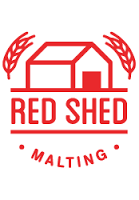 Last week I devoted my CBC column to the arrival of craft malting to Alberta. The timing seemed right as we are on the verge of a mini-explosion of small scale, more artisanal malthouses.
Last week I devoted my CBC column to the arrival of craft malting to Alberta. The timing seemed right as we are on the verge of a mini-explosion of small scale, more artisanal malthouses.
Many of you will know what I am talking about. For those of you who don’t, let me quickly fill you in.
Craft malting is the barley equivalent of craft beer. Small scale, more traditional approaches to malting barley to create a range of flavours and aromas. To quickly take another step back, malting is the process of preparing barley (or any grain) for beer production. It basically starts the germination process then halts it, which develops the much desired sugars yeast loves. Different approaches to kilning and roasting can create a wide range of malts that offer a myriad of flavours and aromas.
Craft brewing started to explode in the U.S. a few years ago and there are currently about 50 craft maltsters in that country. Alberta got its first craft malthouse last year – Red Shed Brewing just outside Red Deer. Those tied into the craft beer industry have known about Red Shed for months, but I think the average craft beer drinker is still yet to learn about them. Hence the column. I make a point of profiling Red Shed and the Hamill brothers to give people a sense of what their story is (listen to the column here).
But wait! There’s more!
Within the next year or so, Alberta will see another 4 craft maltsters open up.There is Hogarth Malting in Olds who will be the first in Alberta to produce floor-malted malt. Floor-malting is an older, more traditional (and more labour intensive) malting process. Then there is Origin Malting in Strathmore, Heritage Malting in Calgary and Hobo Malt in Beiseker, who all hope to open up in the next 6-18 months.
Why should we care about craft malting? I think for three reasons.
 First, it is an extension of local. Red Shed uses barley from its own family farm and other barley farmers near by, meaning the malt never goes more than a couple hundred kilometres to reach your glass.Your beer becomes that much more local.
First, it is an extension of local. Red Shed uses barley from its own family farm and other barley farmers near by, meaning the malt never goes more than a couple hundred kilometres to reach your glass.Your beer becomes that much more local.
Second, it bypasses the big maltsters. Don’t get me wrong the big operators like Rahr and Canada Malting make excellent product and they are not nearly as corporatized as the beer end of the industry. Still, they make large quantities of the same malt designed for the big breweries. That is not a criticism, it is where the market is. The size difference between them and Red Shed, for example, is stunning. Red Shed can produce up to 5 tonnes per week. Rahr in nearby Alix? 3,000 tonnes per week. The scale simply is beyond fathom. Which is Red Shed’s advantage. What they lose in economics of scale, they gain in flexibility and being able to experiment. It is just a way to insert diversity into the market.
Third, it gives more room for brewers to experiment with different flavours and aromas. They can get a one-off batch of malt for a seasonal to create something that they couldn’t have made before and likely won’t again in the future. The craft brewsters are likely not going to be a substantial part of a brewery’s regular line-up, they can’t produce enough. They are ideal for one-offs, seasonals and interesting experiments, like Troubled Monk’s Golden Gaetz malt experiment (which I wrote about here).
Most consumers may never know what impact craft maltsters will have in their beer. But they should. Craft malting has great potential to contribute big things to Alberta-made beer. I look forward to it and I think you should too.


Leave a Reply